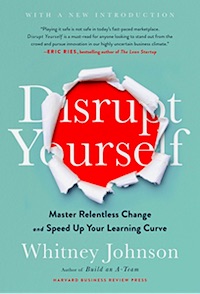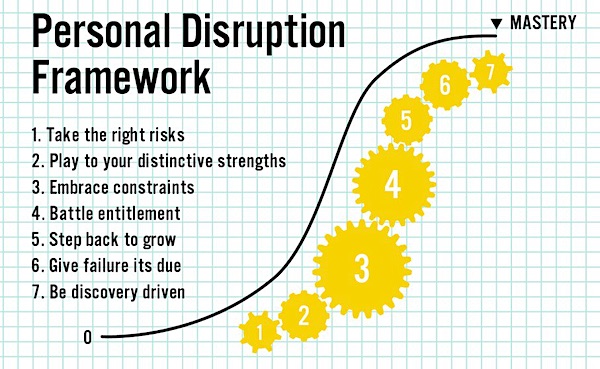 Imagine reframing disruption as opportunity, and adopting the perspective that:
Imagine reframing disruption as opportunity, and adopting the perspective that:
“It’s not a problem. You are always learning.”
That’s how executive coach Whitney Johnson opened her talk in a webinar titled “Thriving in Disruption,” as part of the 100 Leaders Live webinar series. Whitney is the CEO of WLJ Advisors, a “human capital consultancy.”
I learned this from her bio: “She is an expert on helping high-growth organizations develop high-growth individuals. Whitney is an award-winning author, world-class keynote speaker, frequent lecturer for Harvard Business School’s Corporate Learning and an executive coach and advisor to CEOs. In 2017, she was selected from more than 16,000 candidates as a ‘Top 15 Coach’ by Dr. Marshall Goldsmith.”
Her opening comment during the webinar was actually a quote – it’s something her guide said after a hike during her visit to Machu Picchu in Peru with her daughter. Johnson tells the story:
“It was grueling––the kind of hike that gives you a tremendous sense of accomplishment at the finish. I expected it to be hard. I didn’t expect it to be scary. But as we approached the summit, it was. We were on a path no more than four feet wide. No guardrail. Had I slipped—had my daughter slipped—had anyone stumbled, they would likely have plunged to their death, thousands of feet below. I was terrified. I suggested to our guide we turn back. But we were so close, I soldiered on.” (source)
Later, Johnson queried the guide about his work. “Is this hard?” When he replied, “It’s not a problem. You are always learning,” she was so moved by his answer that she now uses it as a mantra to underscore that the fundamental unit of growth in any organization is the individual.
Disruptive Innovation Is Not Limited to Organizations
Whitney Johnson’s belief in the individual as the core unit of growth surfaced during her time working with disruptive innovation expert Clay Christensen. That led her to conclude that disruptive innovation didn’t just apply to organizations; it also applied to individuals.
Creating a personal disruption requires an S-curve cycle of “Learn, Leap, and Repeat.” It introduces cognitive dissonance as the person experiencing the disruption holds on both to her current self or concept and to a different self or concept at the same time.
You May be Undergoing a Personal Disruption
Johnson’s concept of personal disruption certainly applies to what is happening as a result of the coronavirus pandemic. Take a minute to think about the many changes you have made since last March. The word “zoom” now means much more than a car going fast or a camera focusing in. If you are like me, you are using words like “asynchronous” and “synchronous” without much concern that colleagues will know what you mean. And, you are stretching yourself, sometimes wondering whether you might break!
All this is part of the Personal Disruption Framework process, according to Johnson.
During the webinar, Johnson focused on two of the seven components: Step back to grow and Play to your distinctive strengths.
✻ Step Back to Grow
Think about this concept. You crouch before you jump. A baseball pitcher steps back before moving forward. Johnson told stories about four people who were invited to “step back” into a different role to develop specific expertise. In every case, the “invited person” felt demoted, yet over time, the skills they developed propelled them into key leadership positions. To read more about this concept listen to Johnson’s podcasts here, or read this or this.
✻ Play to Your Distinctive Strengths
Just as we can’t always see our areas in need of improvement, we sometimes don’t recognize our strengths. Johnson suggests four questions to help you pinpoint your hidden strength(s) and identify areas you want to strengthen more:
- What exasperates you? If you assume that everyone should be able to understand a concept that you understand – or possess a skill that you’ve mastered – you may be identifying a hidden strength. For example, Johnson pointed to a rather extreme example where former Ford Motor Company President Alan Mulally noted anyone could successfully run a multi-national company.
- What do I daydream about? Your daydreams may be signaling a desire to add a skill or do something different that you sense will play to your strengths. I remember years ago hearing about a new movement in Alabama to improve public education called A+ and started thinking about how exciting and fulfilling it might be to join that fledging nonprofit. Now, almost thirty years later, I’m grateful that daydream turned into reality for me.
- Who do you admire and why? Many people decide to follow in the footsteps of those they admire or at least learn more about what makes them tick. And, even if you don’t become the next Jane Goodall, or whoever you admire, you can learn more about that person’s skills, interests, and talents and incorporate those into your way of being.
- What compliments do you dismiss? Johnson suggests that you write those compliments down and think about them for she believes those compliments you may resist accepting are pointing to your genius.
Learn more!
 Intrigued? You can learn more about Whitney Johnson, her work, and her resources here at her website. Her book Disrupt Yourself has a new pandemic-aware introduction and is a good place to learn more about her concept of riding the “S-curve” of personal learning and growth. The title of her earlier book, Build an A-Team: Play to Their Strengths and Lead Them Up the Learning Curve, may prove irresistible to many school leaders.
Intrigued? You can learn more about Whitney Johnson, her work, and her resources here at her website. Her book Disrupt Yourself has a new pandemic-aware introduction and is a good place to learn more about her concept of riding the “S-curve” of personal learning and growth. The title of her earlier book, Build an A-Team: Play to Their Strengths and Lead Them Up the Learning Curve, may prove irresistible to many school leaders.
So, explore! And perhaps next time you face a problem, you’ll remember what that Machu Picchu guide said: “You’re always learning.”



0 Comments on "How Personal Disruption Can Lead to Professional Growth"